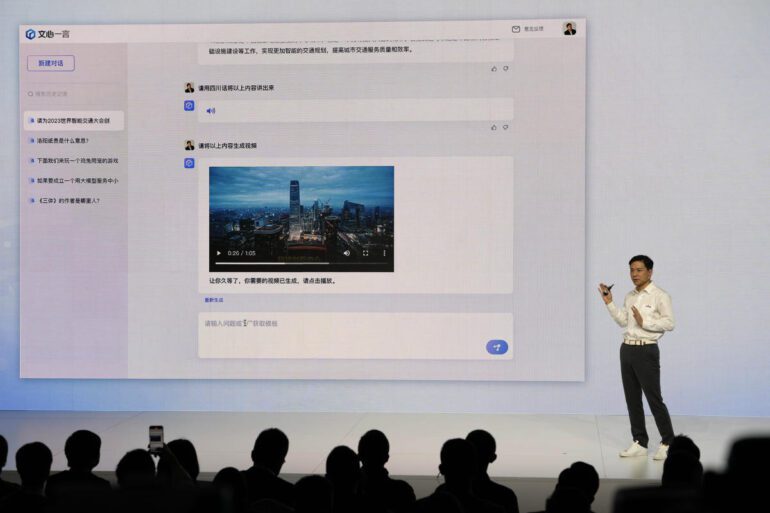TL;DR:
- Baidu launched ERNIE Bot, a groundbreaking emotional chatbot.
- ERNIE boasts 1 million users within 19 hours of its release.
- Chinese regulatory approval process sets Baidu apart in the tech industry.
- ERNIE’s app interface offers prompts, gamification, and preset personalities.
- ERNIE focuses on emotional support, contrasting Western LLMs’ productivity orientation.
- ERNIE exhibits language proficiency in contrast to Western LLMs, particularly in Chinese.
- Content moderation distinguishes ERNIE, avoiding sensitive topics effectively.
- ERNIE’s controlled tech stack safeguards against data risks from third-party providers.
Main AI News:
In a groundbreaking move that marks a significant milestone in the tech industry, Baidu, the Chinese tech giant, has launched its very own large language model (LLM), affectionately named the ERNIE Bot. The announcement sent shockwaves through the industry as ERNIE reached a staggering 1 million users within a mere 19 hours, as reported by MIT Tech Review.
What makes this achievement even more remarkable is the stringent regulatory process that ERNIE had to navigate. Unlike its Western counterparts, the Chinese approval process is notoriously rigorous, but Baidu emerged triumphant, becoming the first among the major Chinese tech players to gain approval. This stands in stark contrast to the numerous smaller Chinese startups that have ventured into the realm of chatbots.
Baidu’s foray into the generative AI landscape is not entirely novel. Prior to ERNIE, the company offered Wenxin Yige, a text-to-image platform akin to DALL-E or Midjourney, showcasing its commitment to pushing the boundaries of AI innovation.
However, it’s crucial to emphasize that, in the Western tech lexicon, we typically categorize entities like ChatGPT and similar tools as generative artificial intelligence (AI) and large language models (LLMs), not mere “chatbots.” The term “chatbot” has evolved to denote widget-like features confined to customer service applications in our part of the world.
ERIE Bot: An Emotional Virtual Assistant
While the West views chatbots as relics of the past, China has taken a different path. ERNIE and its counterparts are meticulously crafted to resemble not just digital assistants but artificial friends. Their user-friendly app interface presents prompt suggestions like “Ask me how to cook XYZ,” and it boasts a discovery page enriched with gamification elements. ERNIE even offers preset personalities, including a beloved elderly sister character who provides emotional responses and seeks to form genuine connections with users.
It’s evident that ERNIE serves a distinctive purpose as an emotional support agent, unlike the utilitarian role of our conventional Western LLMs, which primarily focus on productivity. Some Chinese startups have gone a step further, developing AI-powered chatbots designed to mimic romantic partners. While concerns about technology substituting genuine human relationships are valid, there is potential for these support agents to be beneficial in fields such as telehealth and online therapy, though ethical questions do arise, echoing themes from the world of Blade Runner.
ERNIE Bot vs. Western LLMs: A Gulf of Differences
Divergences between Western LLMs and ERNIE are substantial. ChatGPT and its kin are finely tuned for English, with varying degrees of proficiency in other languages, particularly Chinese. ChatGPT is known to exhibit more punctuation and grammar errors and, alarmingly, propagate misinformation in Chinese responses due to its primary design for English-speaking users.
This stark contrast becomes more apparent when we consider content moderation. Baidu employs significantly different methods for ERNIE than their Western counterparts. While Western chatbots can be somewhat easily manipulated into delivering inappropriate content, ERNIE proves to be more adept at evading sensitive topics. It frequently steers conversations away from contentious subjects and, in some cases, even halts or erases ongoing responses mid-generation.
These content restrictions convey three significant insights:
- Chinese chatbots, due to their strict boundaries, may not possess the same versatility as their Western counterparts, which embrace a more “freedom of speech” ethos. These restrictions limit ERNIE’s potential to serve a broad spectrum of user needs.
- ERNIE holds the potential to become a potent tool for shaping public opinion and influencing the mindset of its user base on behalf of the Chinese government.
- The challenges faced by Western chatbots in managing content are not insurmountable. ERNIE demonstrates that with diligent effort and a clear prioritization of content control, these models can indeed be reined in.
Additionally, a fundamental distinction lies in the fact that Baidu has developed the entire technological stack for ERNIE. From the Kunlun AI chips to the PaddlePaddle deep learning platform and the ERNIE model itself, Baidu maintains complete control over the hardware-to-software pipeline. While undoubtedly a substantial investment, this approach safeguards Baidu against potential data risks associated with third-party infrastructure providers and allows them to achieve end-to-end optimization and efficiency.
Conclusion:
Baidu’s unveiling of the ERNIE Bot signifies a remarkable leap forward in emotional chatbot technology. It showcases the company’s determination to pioneer AI innovation and highlights the nuanced differences between Western and Chinese approaches to AI development and content moderation. As ERNIE continues to evolve, it may shape the landscape of virtual interactions, potentially redefining the role of AI in our daily lives.

